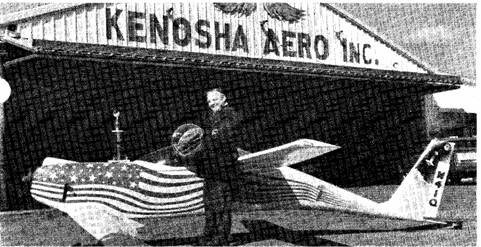 |
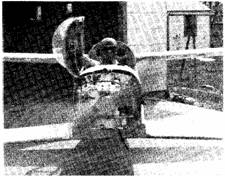
Karl and JimPrell's Quickie nearing completion.
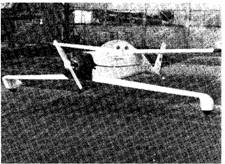
Erhard Winkler from West Germany sent us this picture of his Quickie.
QUICKIE BUILDER TIPS
| 1. |
|
Large
Tire Opthm some builders have reported problems in getting the
tires to rotate freely within the confines of the large tire
wheel pant. The usual complaint has been that the wheel pant
was not wide enough. Generally, we have found the problem to
he due to either tire wobble on the axle, or a wheel pant core
(LG 1) cut narrower than the plans show. However, it is not objectionable
to increase the width of LG 1 slightly (perhaps 1/4”) to
alleviate this problem. We recoin mend 20 psi in the large tires. |
| |
 |
 |
| 2. |
|
Inadequate
Tailwheel Cable Tension One builder recently wrote to us with
the results of inadequate tension on th cables going from the
rudder to the tailwheel; a previous newsletter suggested using
a small spring ‘across’ the two cables to automatically
pro‘ide sufficient tension. The builder did not have the
spring in place. He reported a very high vibration level that
he felt must be due somehow to the engine. After much trial and
error, he discovered that the sloppy tailwheel cables were allowing
the rudder to flutter above 60 mph., thereby creating considerable
fuselage vibration. Once the problem was fixed, the vibration
vent away |
 |
 |
 |
|
A very proud Doug Swammingson; the aircraft's paint job speaks for itself;
Doug is holding the award he recieved at
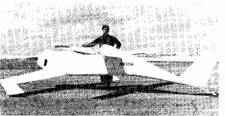
John Bringham's Quickie. Although originally built by Al Rose in Oregon,
the aircraft currently resides in Utah.

Thus
far we have recieved insufficiaent interest in either the new cowling (See
newsletter 16) or the Citroen engine (Also in Newsletter 16) to
proceed with either program at this time. If you are interested in either
program, but have not yet communicated that to QAC, please do so as we
are keeping all names on file. Perhaps by Oshkosh we can announce a go-ahead
on one or both of the programs.
There have been no changes since the last
newsletter on either the Van-Prop or Turbo-Onan programs.
Vic Turner’s Quickie has tested one of Warnke’s ‘almost
constant speed propellers.’ He removed it because of high speed
vibration. Further testing may occur later.
QAC knows of at least 135 Quickies that
have made first flights. That number is rising rapidly. Please advise
QAC if you are planning to fly
your Quickie to Oshkosh ‘82.
With the 22 h.p. engine conversion in the
Quickie, the gross weight is raised to 520 lb. The weight and balance
information contained in Chapter
4 of the Quickie Pilot’s Manual can still be used if the graph
on page 4-5 is extended to 520 lb. At 520 lb., the forward c.g limit
is 24.86; the c.g. imit is 25.78, Both measurements represent the Moment/1000
in-lb.
Please keep builder tips, pictures, component weight information coming
in.
Current delivery on a Quickie kit is 3
weeks. Most components, including engines, are in stock. Current prices
are |
the Dayton Air Fair, note also the attractive hood ornament.
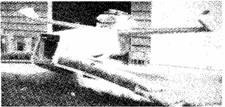
From the QAC archives: An old picture of Garry LeGare's Quickie being load
tested for the Canadian MOT approval. Garry's Quickie was the first one
to fly in Canada.
$3,295.00
forPackage 1 and $1,700.00 for Package 2. Note that the complete kit now
consists of two packages instead of the original three.
Available
options are as follows:
$125.00
|
|
Large Tire Option. |
300.00
|
|
22.5 h.p. Option including Kevlar engine mount. |
125.00
|
|
Kevlar engine mount separate. |
125.00
|
|
Custom Upholstery set. |
51.00
|
|
Prefabricated fuel tank. (Standard with Package
1) |
13.50
|
|
Communications or Navigation Antenna kit. |
150.00
|
|
44” diameter propeller. (Discounted price
for currently flying builders). |
 |
 |
 |
The
44” diameter propeller is to be used with the large tire option and
22 h.p. engine option. This propeller provides greater rate-of-climb (about
20%) with a loss in top speed of about 4 mph. It would be particularly
useful for short fields at higher density altitudes.
Please
keep your builder tips, comments and queries coming.
For
those builders who would like a true climb propeller for the first few
flights, rather than the cruise propeller provided with the kits, we have
created a 42” diameter, 27” pitch climb propeller and will
make it available as follows: with a deposit by the builder of $150.00,
we will send the special prop to the builder for his initial flights. When
he returns the prop to us in good shape, prepaid freight, we will return
his complete deposit.
|








